Performance Testing of Optical Flow Time Series Analyses Based on a Fast, High-Alpine Landslide
Abstract
1. Introduction
- Is the dense inverse search (DIS) method applicable to the large displacements of landslides with complex behaviours?
- Can the method investigate both slow and moderate velocities between repeated observation intervals?
- Is the DIS method robust enough to cope with the changing and unfavourable illumination of a high-alpine steep study site?
- How does the DIS method perform in comparison to the well-established phase correlation algorithm?
2. A Complex Landslide
3. Materials and Methods
3.1. UAS Image Acquisition and Processing
3.2. Displacement Calculation and Derivation of Displacement Curves
3.3. Accuracy Assessment and Result Validation
3.4. Atmospheric and Hydrological Conditions
4. Results
4.1. Accuracy Assessment: Stable Areas and Ground Truth Comparison
4.2. Total Displacement for Single Analysis
4.3. Total Displacement for Multimaster Analysis and Displacement Curves
4.4. Meteorological Data
5. Discussion
6. Conclusions
Supplementary Materials
Author Contributions
Funding
Informed Consent Statement
Acknowledgments
Conflicts of Interest
Appendix A
| Finest Scale | Patch Size | Patch Stride | Gradient Descending Iterations | Use Mean Normalisation | Use Spatial Propagation | Var. Refinement Alpha | Var. Refinement Delta | Var. Refinement Gamma | Var. Refinement Iterations | |
|---|---|---|---|---|---|---|---|---|---|---|
| Interval I | 0 | 8 | 3 | 25 | x | x | 20 | 5 | 10 | 5 |
| Interval II | 0 | 8 | 3 | 25 | x | x | 20 | 5 | 10 | 5 |
| Interval III | 0 | 16 | 2 | 30 | x | x | 15 | 5 | 10 | 10 |
| Interval IV | 0 | 8 | 3 | 25 | x | x | 15 | 5 | 10 | 10 |
| Interval 1–3 | 0 | 8 | 3 | 25 | x | x | 15 | 5 | 10 | 10 |
| Interval 1–4 | 0 | 8 | 3 | 25 | x | x | 20 | 5 | 10 | 5 |
| Interval 2–4 | 0 | 8 | 3 | 25 | x | x | 20 | 5 | 10 | 5 |
| Interval 2–5 | 0 | 8 | 3 | 25 | x | x | 20 | 5 | 10 | 5 |
References
- Huggel, C.; Clague, J.; Korup, O. Is climate change responsible for changing landslide activity in high mountains? Earth Surf. Processes Landf. 2012, 37, 77–91. [Google Scholar] [CrossRef]
- Lacroix, P.; Araujo, G.; Hollingsworth, J.; Taipe, E. Self-Entrainment Motion of a Slow-Moving Landslide Inferred from Landsat-8 Time Series. J. Geophys. Res. Earth Surf. 2019, 124, 1201–1216. [Google Scholar] [CrossRef]
- Scaioni, M.; Longoni, L.; Melillo, V.; Papini, M. Remote Sensing for Landslide Investigations: An Overview of Recent Achievements and Perspectives. Remote Sens. 2014, 6, 9600–9652. [Google Scholar] [CrossRef]
- Moretto, S.; Bozzano, F.; Esposito, C.; Mazzanti, P.; Rocca, A. Assessment of Landslide Pre-Failure Monitoring and Forecasting Using Satellite SAR Interferometry. Geosciences 2017, 7, 36. [Google Scholar] [CrossRef]
- Travelletti, J.; Delacourt, C.; Allemand, P.; Malet, J.-P.; Schmittbuhl, J.; Toussaint, R.; Bastard, M. Correlation of multi-temporal ground-based optical images for landslide monitoring: Application, potential and limitations. J. Photogramm. Remote Sens. 2012, 70, 39–55. [Google Scholar] [CrossRef]
- Romeo, S.; Cosentino, A.; Giani, F.; Mastrantoni, G.; Mazzanti, P. Combining Ground Based Remote Sensing Tools for Rockfalls Assessment and Monitoring: The Poggio Baldi Landslide Natural Laboratory. Sensors 2021, 21, 2632. [Google Scholar] [CrossRef] [PubMed]
- Voordendag, A.; Goger, B.; Klug, C.; Prinz, R.; Rutzinger, M.; Kaser, G. Automated and permanent long-range terrestrial laser scanning in a high mountain environment: Setup and first results. ISPRS Ann. Photogramm. Remote Sens. Spat. Inf. Sci. 2021, 2, 153–160. [Google Scholar] [CrossRef]
- Scherler, D.; Leprince, S.; Strecker, M. Glacier-surface velocities in alpine terrain from optical satellite imagery—Accuracy improvement and quality assessment. Remote Sens. Environ. 2008, 112, 3806–3819. [Google Scholar] [CrossRef]
- Heid, T.; Kääb, A. Evaluation of existing image matching methods for deriving glacier surface displacements globally from optical satellite imagery. Remote Sens. Environ. 2012, 118, 339–355. [Google Scholar] [CrossRef]
- Nagy, T.; Andreassen, L.M.; Duller, R.A.; Gonzalez, P.J. SenDiT: The Sentinel-2 Displacement Toolbox with Application to Glacier Surface Velocities. Remote Sens. 2019, 11, 1151. [Google Scholar] [CrossRef]
- Leprince, S.; Barbot, S.; Ayoub, F.; Avouac, J.-P. Automatic and Precise Orthorectification, Coregistration, and Subpixel Correlation of Satellite Images, Application to Ground Deformation Measurements. IEEE Trans. Geosci. Remote Sens. 2007, 45, 1529–1558. [Google Scholar] [CrossRef]
- Ayoub, F.; Leprince, S.; Avouac, J.-P. Co-registration and correlation of aerial photographs for ground deformation measurements. ISPRS J. Photogramm. Remote Sens. 2009, 64, 551–560. [Google Scholar] [CrossRef]
- Kääb, A.; Altena, B.; Mascaro, J. Coseismic displacements of the 14 November 2016 Mw 7.8 Kaikoura, New Zealand, earthquake using the Planet optical cubesat constellation. Nat. Hazards Earth Syst. Sci. 2017, 17, 627–639. [Google Scholar] [CrossRef]
- Leprince, S.; Berthier, E.; Ayoub, F.; Delacourt, C.; Avouac, J.-P. Monitoring Earth Surface Dynamics with Optical Imagery. Eos 2008, 89, 1–12. [Google Scholar] [CrossRef]
- Michel, S.; Avouac, J.-P.; Ayoub, F.; Ewing, R.C.; Vriend, N.; Heggy, E. Comparing dune migration measured from remote sensing with sand flux prediction based on weather data and model, a test case in Qatar. Earth Planet. Sci. Lett. 2018, 497, 12–21. [Google Scholar] [CrossRef]
- Debella-Gilo, M.; Kääb, A. Sub-pixel precision image matching for measuring surface displacements on mass movements using normalized cross-correlation. Remote Sens. Environ. 2011, 115, 130–142. [Google Scholar] [CrossRef]
- Lucieer, A.; de Jong, S.; Turner, D. Mapping landslide displacements using Structure from Motion (SfM) and image correlation of multi-temporal UAV photography. Prog. Phys. Geogr. 2014, 38, 97–116. [Google Scholar] [CrossRef]
- Stumpf, A.; Malet, J.-P.; Allemand, P.; Ulrich, P. Surface reconstruction and landslide displacement measurements with Pléiades satellite images. ISPRS J. Photogramm. Remote Sens. 2014, 95, 1–12. [Google Scholar] [CrossRef]
- Turner, D.; Lucieer, A.; de Jong, S. Time Series Analysis of Landslide Dynamics Using an Unmanned Aerial Vehicle (UAV). Remote Sens. 2015, 7, 1736–1757. [Google Scholar] [CrossRef]
- Bickel, V.; Manconi, A.; Amann, F. Quantitative Assessment of Digital Image Correlation Methods to Detect and Monitor Surface Displacements of Large Slope Instabilities. Remote Sens. 2018, 10, 865. [Google Scholar] [CrossRef]
- Caporossi, P.; Mazzanti, P.; Bozzano, F. Digital Image Correlation (DIC) Analysis of the 3 December 2013 Montescaglioso Landslide (Basilicata, Southern Italy): Results from a Multi-Dataset Investigation. ISPRS Int. J. Geo-Inf. 2018, 7, 372. [Google Scholar] [CrossRef]
- Lacroix, P.; Bièvre, G.; Pathier, E.; Kniess, U.; Jongmans, D. Use of Sentinel-2 images for the detection of precursory motions before landslide failures. Remote Sens. Environ. 2018, 215, 507–516. [Google Scholar] [CrossRef]
- Mazzanti, P.; Caporossi, P.; Muzi, R. Sliding Time Master Digital Image Correlation Analyses of CubeSat Images for landslide Monitoring: The Rattlesnake Hills Landslide (USA). Remote Sens. 2020, 12, 592. [Google Scholar] [CrossRef]
- Mulas, M.; Ciccarese, G.; Truffelli, G.; Corsini, A. Integration of Digital Image Correlation of Sentinel-2 Data and Continuous GNSS for Long-Term Slope Movements Monitoring in Moderately Rapid Landslides. Remote Sens. 2020, 12, 2605. [Google Scholar] [CrossRef]
- Hermle, D.; Keuschnig, M.; Hartmeyer, I.; Delleske, R.; Krautblatter, M. Timely prediction potential of landslide early warning systems with multispectral remote sensing: A conceptual approach tested in the Sattelkar, Austria. Nat. Hazards Earth Syst. Sci. 2021, 21, 2753–2772. [Google Scholar] [CrossRef]
- Zitová, B.; Flusser, J. Image registration methods: A survey. Image Vis. Comput. 2003, 21, 977–1000. [Google Scholar] [CrossRef]
- Smith, M.W.; Carrivick, J.L.; Quincey, D.J. Structure from motion photogrammetry in physical geography. Prog. Phys. Geogr. Earth Environ. 2016, 40, 247–275. [Google Scholar] [CrossRef]
- Scheffler, D.; Hollstein, A.; Diedrich, H.; Segl, K.; Hostert, P. AROSICS: An Automated and Robust Open-Source Image Co-Registration Software for Multi-Sensor Satellite Data. Remote Sens. 2017, 9, 676. [Google Scholar] [CrossRef]
- Dawn, S.; Vikas, S.; Sharma, B. Remote Sensing Image Registration Techniques: A Survey. In Image and Signal Processing, Proceedings of the 4th International Conference, ICISP 2010, Trois-Rivières, QC, Canada, 30 June—2 July 2010; Elmoataz, A., Lezoray, O., Nouboud, F., Mammass, D., Meunier, J., Eds.; Springer: Berlin, Germany, 2010; pp. 103–112. ISBN 3-642-13680-X. [Google Scholar]
- Bracewell, R.N. The Fourier Transform and Its Applications; McGraw-Hill: New York, NY, USA, 1965. [Google Scholar]
- Foroosh, H.; Zerubia, J.B.; Berthod, M. Extension of phase correlation to subpixel registration. IEEE Trans. Image Process. 2002, 11, 188–200. [Google Scholar] [CrossRef] [PubMed]
- Mohammed, A.S.; Helmi, A.K.; Fkirin, M.A.; Badwai, S.M. Subpixel Accuracy Analysis of Phase Correlation Shift Measurement Methods Applied to Satellite Imagery. Int. J. Adv. Comput. Sci. Appl. 2012, 3, 202–206. [Google Scholar] [CrossRef][Green Version]
- Tong, X.; Ye, Z.; Xu, Y.; Gao, S.; Xie, H.; Du, Q.; Liu, S.; Xu, X.; Liu, S.; Luan, K.; et al. Image Registration with Fourier-Based Image Correlation: A Comprehensive Review of Developments and Applications. IEEE J. Sel. Top. Appl. Earth Obs. Remote Sens. 2019, 12, 4062–4081. [Google Scholar] [CrossRef]
- Lucas, B.; Kanade, T. An iterative image registration technique with an application to stereo vision. In Proceedings of the Seventh International Joint Conference on Artificial Intelligence, Vancouver, BC, Canada, 24–28 August 1981; pp. 674–679. [Google Scholar]
- Rosenfeld, A.; Vanderbrug, G.J. Coarse-fine template matching. IEEE Trans. Syst. Man Cybern. 1977, 7, 104–107. [Google Scholar]
- Scambos, T.A.; Dutkiewicz, M.J.; Wilson, J.C.; Bindschadler, R.A. Application of image cross-correlation to the measurement of glacier velocity using satellite image data. Remote Sens. Environ. 1992, 42, 177–186. [Google Scholar] [CrossRef]
- Fahnestock, M.; Scambos, T.; Moon, T.; Gardner, A.; Haran, T.M.; Klinger, M. Rapid large-area mapping of ice flow using Landsat 8. Remote Sens. Environ. 2016, 185, 84–94. [Google Scholar] [CrossRef]
- Rosu, A.-M.; Pierrot-Deseilligny, M.; Delorme, A.; Binet, R.; Klinger, Y. Measurement of ground displacement from optical satellite image correlation using the free open-source software MicMac. ISPRS J. Photogramm. Remote Sens. 2015, 100, 48–59. [Google Scholar] [CrossRef]
- Kääb, A.; Vollmer, M. Surface Geometry, Thickness Changes and Flow Fields on Creeping Mountain Permafrost: Automatic Extraction by Digital Image Analysis. Permafr. Periglac. Processes 2000, 11, 315–326. [Google Scholar] [CrossRef]
- Schwalbe, E.; Maas, H.-G. The determination of high-resolution spatio-temporal glacier motion fields from time-lapse sequences. Earth Surf. Dynam. 2017, 5, 861–879. [Google Scholar] [CrossRef]
- Delacourt, C.; Allemand, P.; Berthier, E.; Raucoules, D.; Casson, B.; Grandjean, P.; Pambrun, C.; Varel, E. Remote-sensing techniques for analysing landslide kinematics: A review. Bull. Soc. Geol. Fr. 2007, 178, 89–100. [Google Scholar] [CrossRef]
- Stumpf, A.; Malet, J.-P.; Puissant, A.; Travelletti, J. Monitoring of Earth Surface Motion and Geomorphologic Processes by Optical Image Correlation: Chapter 5. In Land Surface Remote Sensing: Environment and Risks; Baghdadi, N., Zribi, F.M., Eds.; ISTE Press—Elsevier: Amsterdam, The Netherlands, 2016; pp. 147–190. ISBN 9781785481055. [Google Scholar]
- Fortun, D.; Bouthemy, P.; Kervrann, C. Optical flow modeling and computation: A survey. Comput. Vis. Image Underst. 2015, 134, 1–26. [Google Scholar] [CrossRef]
- Horn, B.K.; Schunck, B.G. Determining optical flow. Artif. Intell. 1981, 17, 185–203. [Google Scholar] [CrossRef]
- Baker, S.; Scharstein, D.; Lewis, J.P.; Roth, S.; Black, M.J.; Szeliski, R. A Database and Evaluation Methodology for Optical Flow. Int. J. Comput. Vis. 2011, 92, 1–31. [Google Scholar] [CrossRef]
- Vogel, C.; Bauder, A.; Schindler, K. Optical flow for glacier motion estimation. ISPRS Ann. Photogramm. Remote Sens. Spat. Inf. Sci. 2012, I-3, 359–365. [Google Scholar] [CrossRef]
- Altena, B.; Kääb, A. Weekly Glacier Flow Estimation from Dense Satellite Time Series Using Adapted Optical Flow Technology. Front. Earth Sci. 2017, 5, 53. [Google Scholar] [CrossRef]
- Kroeger, T.; Timofte, R.; Dai, D.; van Gool, L. Fast Optical Flow Using Dense Inverse Search. In Computer Vision—ECCV 2016, Lecture Notes in Computer Science, Proceedings of the European Conference on Computer Vision, Amsterdam, The Netherlands, 11–14 October 2016; Leibe, B., Matas, J., Sebe, N., Welling, M., Eds.; Springer: Cham, Switzerland, 2016; pp. 471–488. ISBN 978-3-319-46492-3. [Google Scholar]
- Baker, S.; Matthews, I. Equivalence and efficiency of image alignment algorithms. In Proceedings of the 2001 IEEE Computer Society Conference on Computer Vision and Pattern Recognition, CVPR, Kauai, HI, USA, 8–14 December 2001; pp. 1–8. [Google Scholar]
- Baker, S.; Matthews, I. Lucas-Kanade 20 Years On: A Unifying Framework. Int. J. Comput. Vis. 2004, 56, 221–255. [Google Scholar] [CrossRef]
- Brox, T.; Bregler, C.; Malik, J. Large displacement optical flow. In Proceedings of the IEEE Conference on Computer Vision, Miami, FL, USA, 20–25 June 2009; pp. 41–48, ISBN 1063-6919. [Google Scholar]
- Plank, S.; Krautblatter, M.; Thuro, K. Feasibility Assessment of Landslide Monitoring by Means of SAR Interferometry: A Case Study in the Ötztal Alps, Austria. In Engineering Geology for Society and Territory; Lollino, G., Giordan, D., Crosta, G.B., Corominas, J., Azzam, R., Wasowski, J., Sciarra, N., Eds.; Springer International Publishing: Cham, Switzerland, 2015; Volume 2, pp. 375–378. ISBN 978-3-319-09056-6. [Google Scholar]
- Moretto, S.; Bozzano, F.; Esposito, C.; Mazzanti, P. Lesson learned from the pre-collapse time series of displacement of the Preonzo landslide (Switzerland). Rend. Online Soc. Geol. Ital. 2016, 41, 247–250. [Google Scholar] [CrossRef]
- Sudmanns, M.; Tiede, D.; Augustin, H.; Lang, S. Assessing global Sentinel-2 coverage dynamics and data availability for operational Earth observation (EO) applications using the EO-Compass. Int. J. Digit. Earth 2019, 768–784. [Google Scholar] [CrossRef]
- Clapuyt, F.; Vanacker, V.; van Oost, K. Reproducibility of UAV-based earth topography reconstructions based on Structure-from-Motion algorithms. Geomorphology 2016, 260, 4–15. [Google Scholar] [CrossRef]
- Peppa, M.V.; Mills, J.P.; Moore, P.; Miller, P.E.; Chambers, J.E. Brief communication: Landslide motion from cross correlation of UAV-derived morphological attributes. Nat. Hazards Earth Syst. Sci. 2017, 17, 2143–2150. [Google Scholar] [CrossRef]
- Hungr, O.; Leroueil, S.; Picarelli, L. The Varnes classification of landslide types, an update. Landslides 2014, 11, 167–194. [Google Scholar] [CrossRef]
- Barsi, Á.; Kugler, Z.; László, I.; Szabó, G.; Abdulmutalib, H.M. Accuracy dimensions in remote sensing. Int. Arch. Photogramm. Remote Sens. Spat. Inf. Sci. 2018, XLII-3, 61–67. [Google Scholar] [CrossRef]
- Anker, F.; Fegerl, L.; Hübl, J.; Kaitna, R.; Neumayer, F.; Keuschnig, M. Geschiebetransport in Gletscherbächen der Hohen Tauern: Beispiel Obersulzbach. Wildbach Lawinenverbauung 2016, 80, 86–96. [Google Scholar]
- GeoResearch. Projekt Sattelkar: Zwischenbericht 1: 2018. Klimasensitive, Hochalpine Kare. 2018. Available online: http://www.parcs.at/nphts/mmd_fullentry.php?docu_id=37640 (accessed on 29 November 2021).
- GeoResearch. Projekt Sattelkar: Zwischenbericht 3: 2020. Klimasensitive, Hochalpine Kare. 2020. Available online: http://www.parcs.at/nphts/mmd_fullentry.php?docu_id=41348 (accessed on 29 November 2021).
- Schrott, L.; Otto, J.-C.; Keller, F. Modelling alpine permafrost distribution in the Hohe Tauern region, Austria. Austrian J. Earth Sci. 2012, 105, 169–183. [Google Scholar]
- OpenCV: Dense Optical Flow. Available online: https://docs.opencv.org/3.4/d4/dee/tutorial_optical_flow.html (accessed on 6 November 2021).
- Leys, C.; Delacre, M.; Mora, Y.L.; Lakens, D.; Ley, C. How to Classify, Detect, and Manage Univariate and Multivariate Outliers, With Emphasis on Pre-Registration. Int. Rev. Soc. Psychol. 2019, 32, 5. [Google Scholar] [CrossRef]
- Segoni, S.; Battistini, A.; Rossi, G.; Rosi, A.; Lagomarsino, D.; Catani, F.; Moretti, S.; Casagli, N. Preface: An operational landslide early warning system at regional scale based on space–time-variable rainfall thresholds. Nat. Hazards Earth Syst. Sci. 2015, 15, 853–861. [Google Scholar] [CrossRef]
- Corominas, J.; Remondo, J.; Farias, P.; Zézere, J.; Estevao, M.; Díaz de Teràn, J.; Schrott, L.; Dikau, R.; Moya, J.; González, A. Debris flow. In Landslide Recognition: Identification, Moevement and Courses; Dikau, R., Brundsen, D., Schrott, L., Ibsen, M.-L., Eds.; John Wiley & Sons: New York, NY, USA, 1996; p. 161. ISBN 0471964778. [Google Scholar]
- Fleet, D.J.; Black, M.J.; Yacoob, Y.; Jepson, A.D. Design and Use of Linear Models for Image Motion Analysis. Int. J. Comput. Vis. 2000, 36, 171–193. [Google Scholar] [CrossRef]
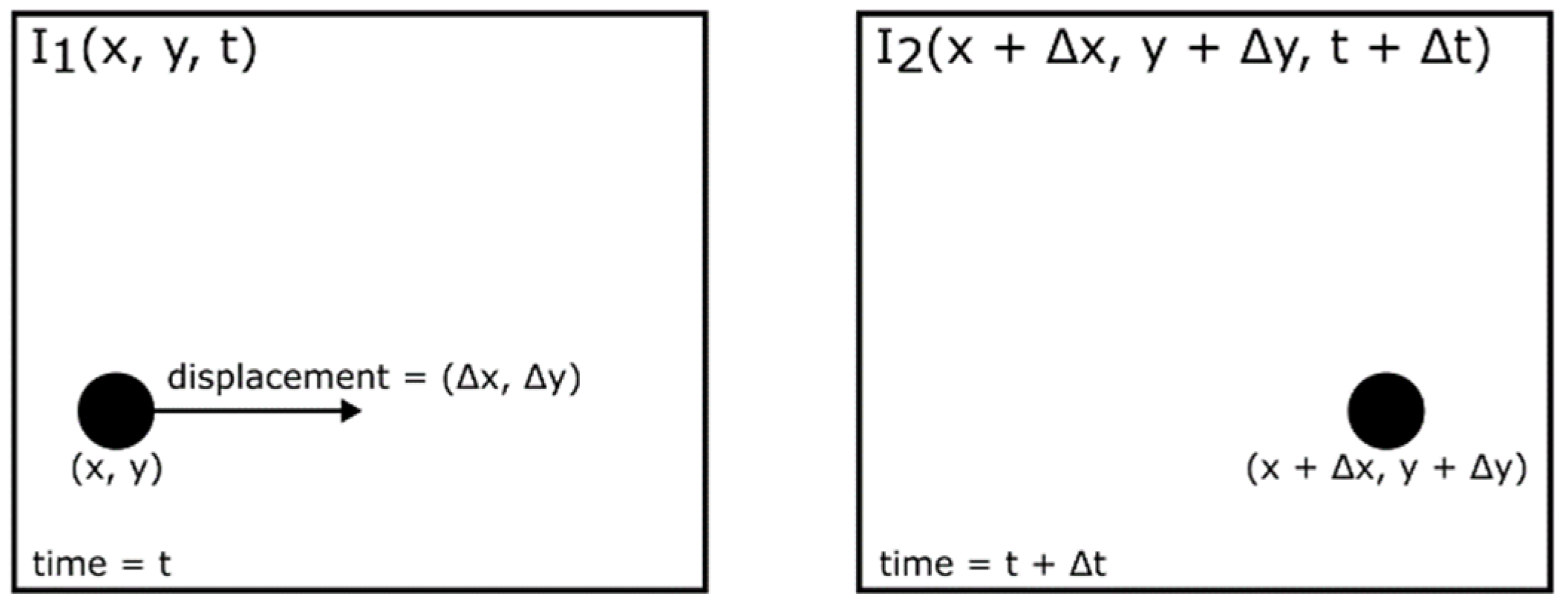
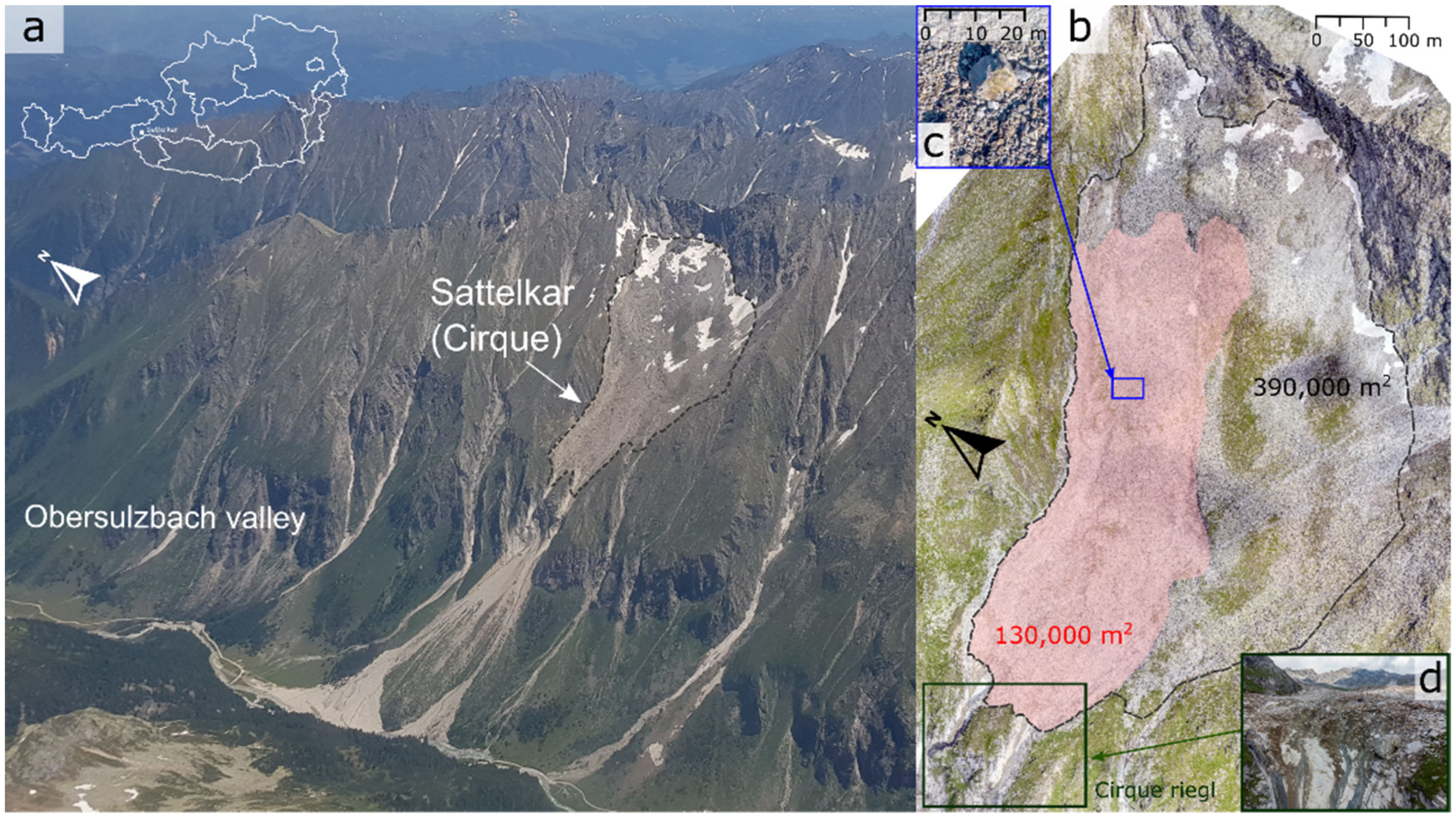

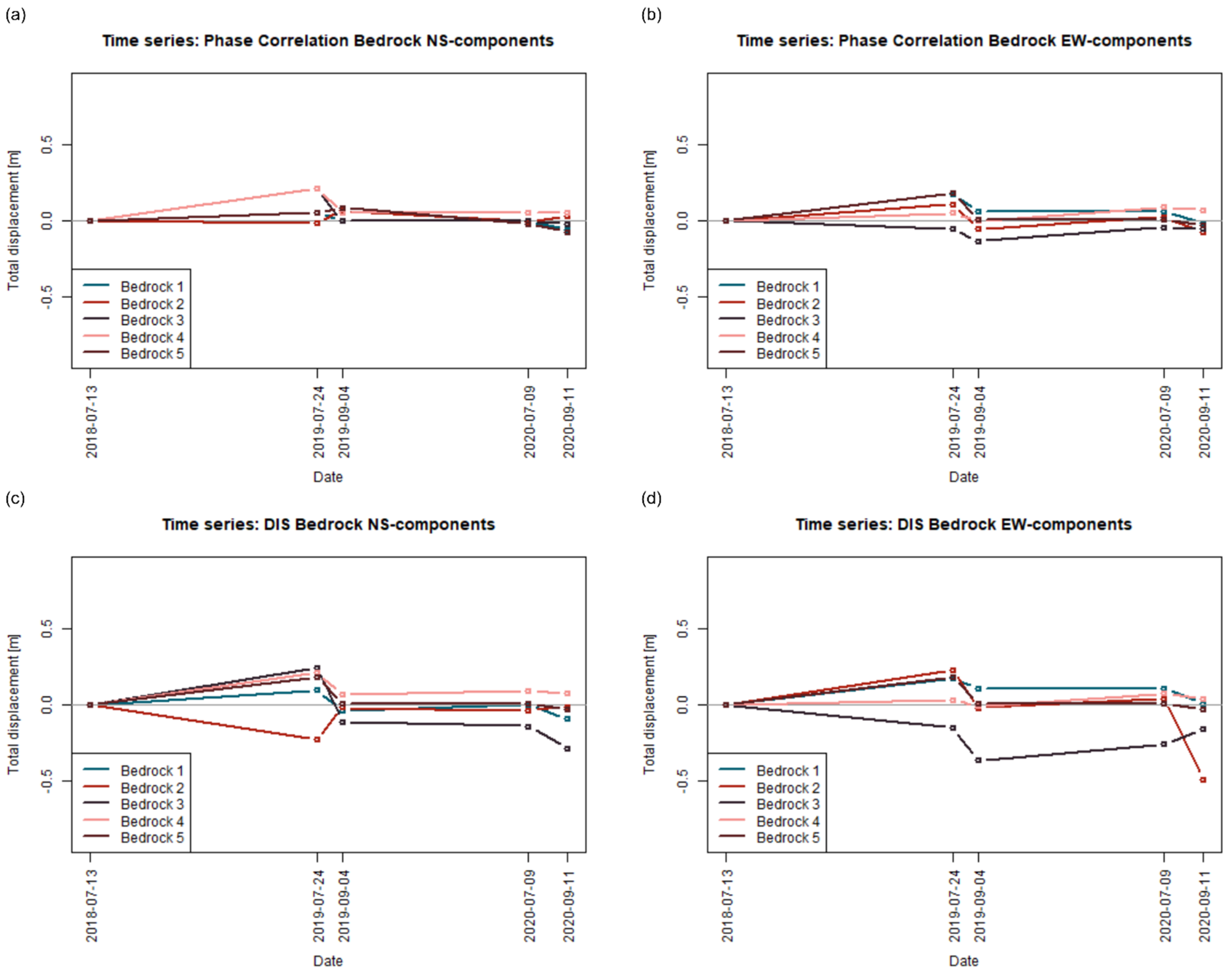
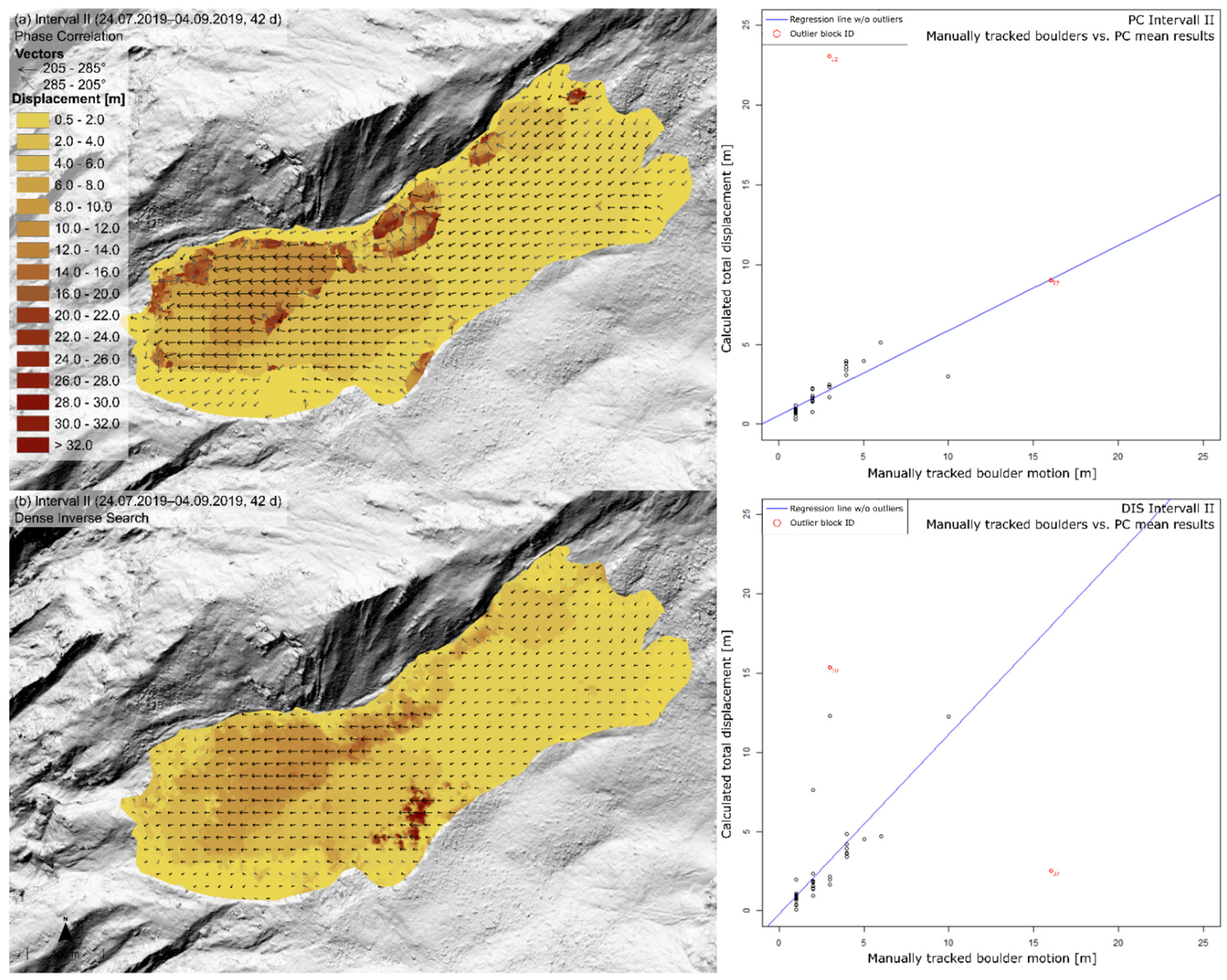
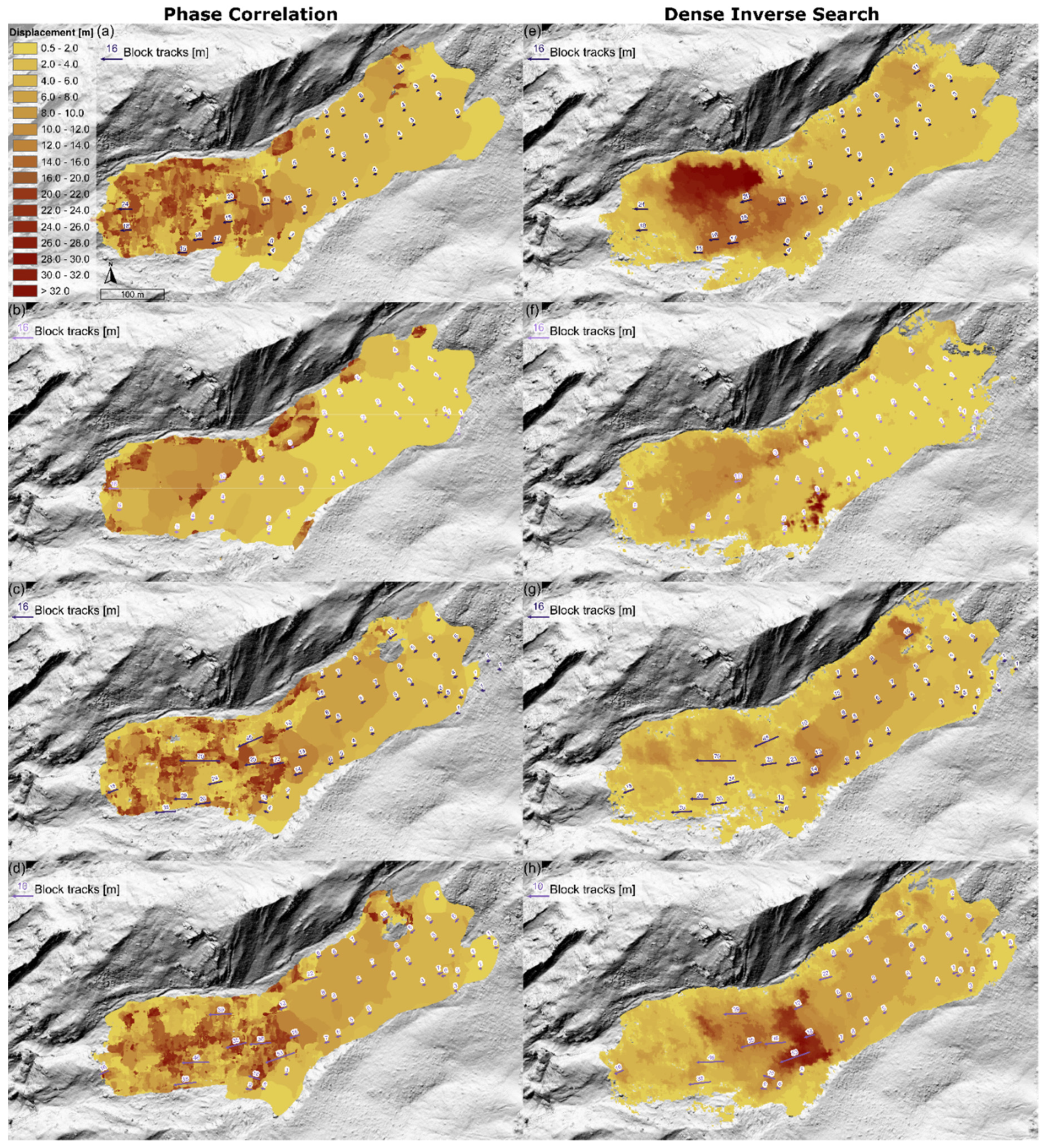
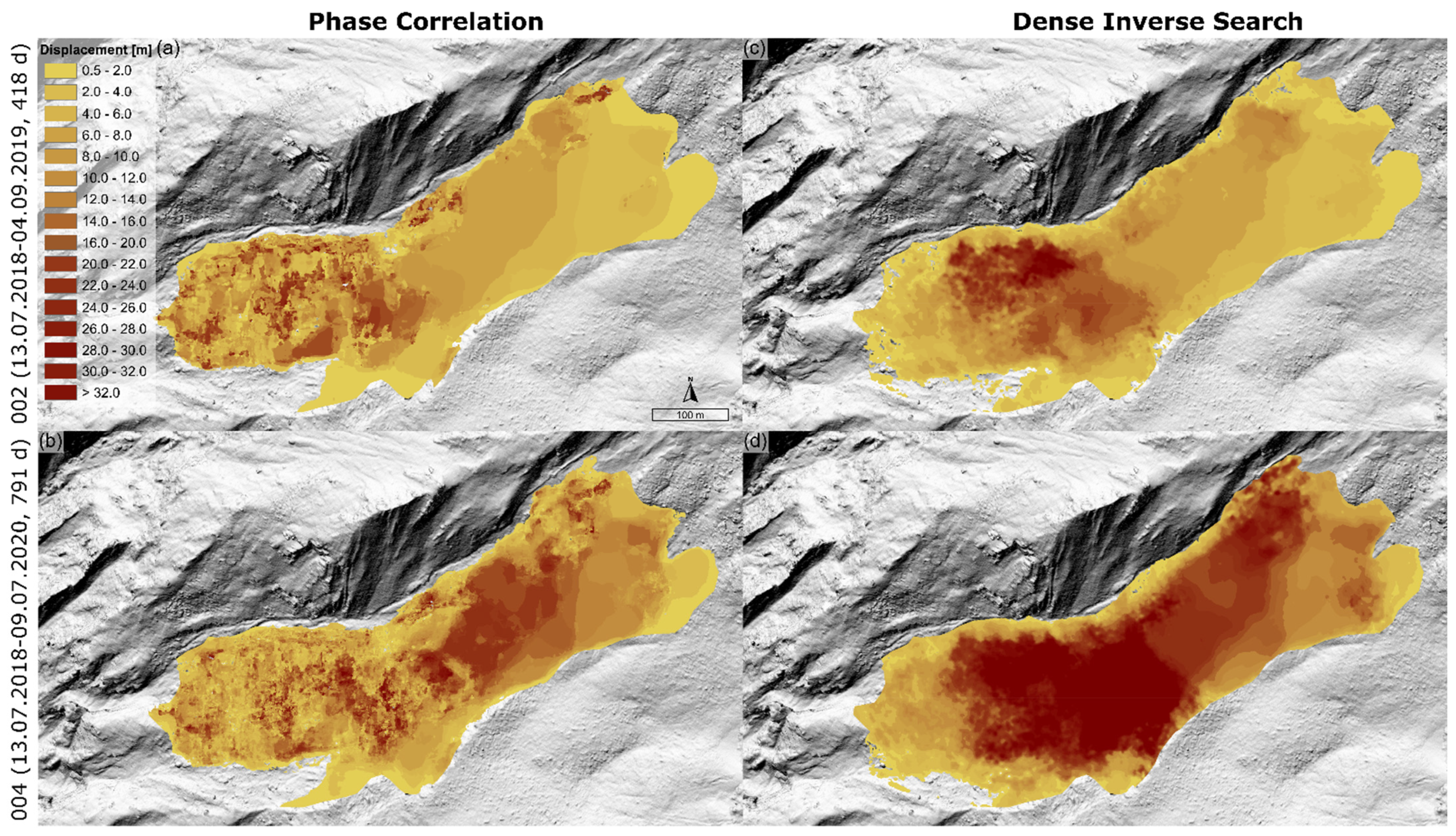
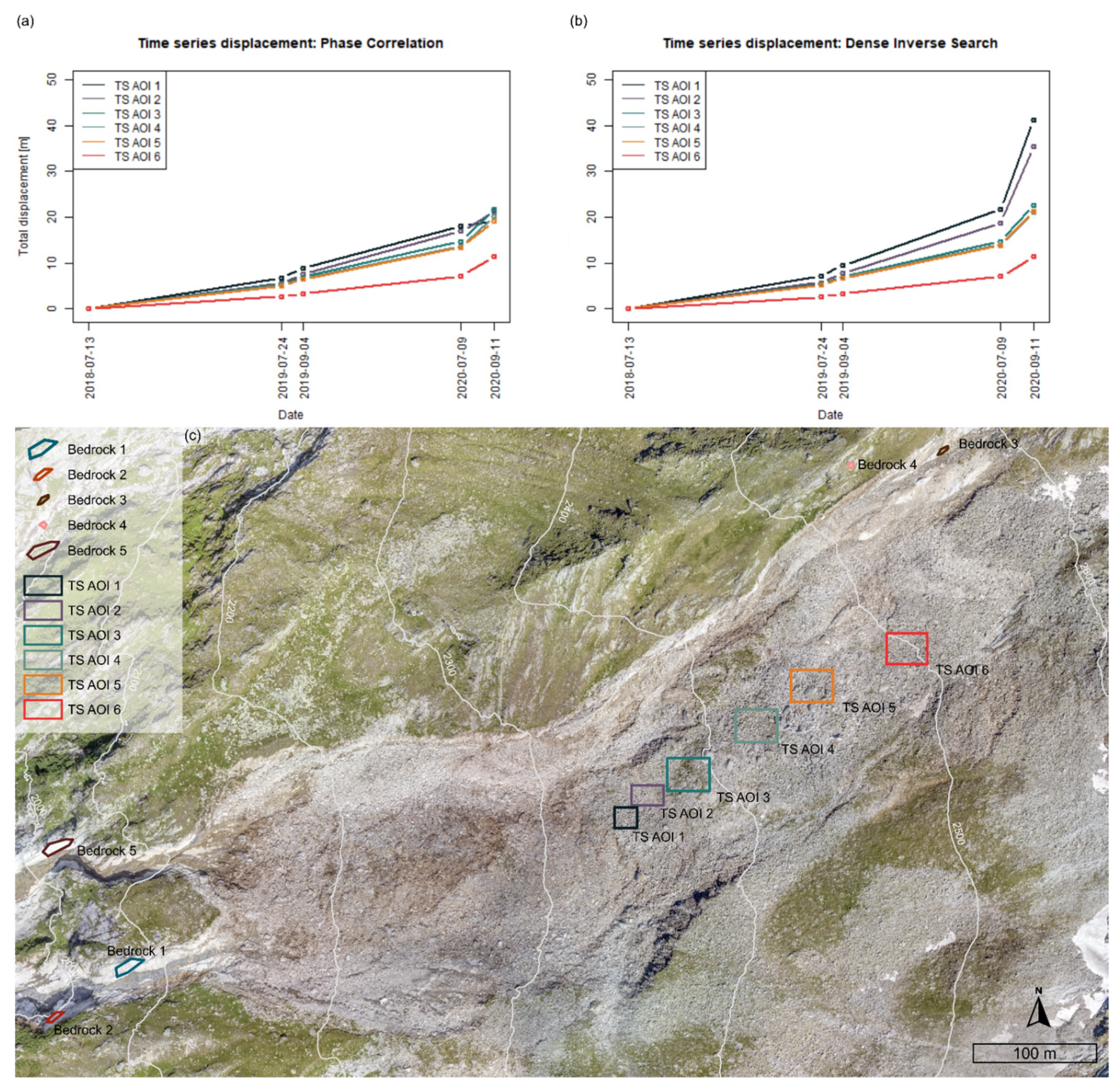
| Acquisition Dates | Intervals Single Analysis | Intervals Multimaster Analysis | ||||||||||
|---|---|---|---|---|---|---|---|---|---|---|---|---|
| 13 July 2018 | (I): 376 | (I): 376 | (1.-3.): 418 | (1.-4.): 727 | (1.-5.): 791 | (0001): 376 | (0002): 418 | (0003): 727 | (0004): 791 | |||
| 24 July 2019 | (II): 42 | (2.-4.): 351 | (2.-5.): 415 | |||||||||
| 4 September 2019 | (III): 309 | |||||||||||
| 9 July 2020 | (IV): 64 | |||||||||||
| 11 September 2020 | ||||||||||||
| Flight Plan Parts | Length of Flightpath [km] | Flight Time [min] | Passes | No. of Images | GSD | Altitude Startpoint [m] | Highest Flight Position [m] | Lowest Terrain Point [m] |
|---|---|---|---|---|---|---|---|---|
| Top | 6.8 | 17 | 6 | 121 | 7 | 2630 | 3120 | 2365 |
| Middle | 7.5 | 19 | 6 | 135 | 7 | 2200 | 2682 | 1820 |
| Low 1 | 7.3 | 17 | 6 | 130 | 7 | 1768 | 2115 | 1620 |
| Low 2 | 5.6 | 14 | 6 | 81 | 7 | 1768 | 2110 | 1620 |
| Total | 27.2 | 67 | 24 | 467 | 7 | 3120 | 1620 |
| TS AOI No./Bedrock No. | 1 | 2 | 3 | 4 | 5 | 6 |
|---|---|---|---|---|---|---|
| Time Series AOI [m²] | 337.94 | 457.09 | 988.15 | 974.03 | 969.85 | 893.25 |
| Bedrock [m²] | 162.095 | 50.31 | 23.95 | 13.79 | 167.50 | - |
| >20 [mm] | >30 [mm] | >40 [mm] | >50 [mm] | |
|---|---|---|---|---|
| 2009 | 12 | 5 | 3 | 2 |
| 2010 | 8 | 4 | 2 | 1 |
| 2011 | 10 | 3 | 1 | 0 |
| 2012 | 16 | 5 | 2 | 1 |
| 2013 | 6 | 1 | 0 | 0 |
| 2014 | 9 | 5 | 3 | 2 |
| 2015 | 18 | 6 | 1 | 0 |
| 2016 | 10 | 5 | 0 | 0 |
| 2017 | 10 | 4 | 0 | 0 |
| 2018 | 10 | 5 | 2 | 1 |
| 2019 | 11 | 1 | 1 | 1 |
| 2020 | 16 | 8 | 6 | 2 |
| Date | Precipitation [mm] |
|---|---|
| 29 August 2020 | 82.9 |
| 30 July 2014 | 76.1 |
| 27 April 2009 | 70.1 |
| 3 October 2020 | 62.8 |
| 11 June 2014 | 60.4 |
| 19 August 2017 | 57.2 |
| 6 June 2009 | 52.5 |
| 17 July 2010 | 52.3 |
| 28 July 2019 | 51.2 |
| 3 August 2020 | 50.0 |
Publisher’s Note: MDPI stays neutral with regard to jurisdictional claims in published maps and institutional affiliations. |
© 2022 by the authors. Licensee MDPI, Basel, Switzerland. This article is an open access article distributed under the terms and conditions of the Creative Commons Attribution (CC BY) license (https://creativecommons.org/licenses/by/4.0/).
Share and Cite
Hermle, D.; Gaeta, M.; Krautblatter, M.; Mazzanti, P.; Keuschnig, M. Performance Testing of Optical Flow Time Series Analyses Based on a Fast, High-Alpine Landslide. Remote Sens. 2022, 14, 455. https://doi.org/10.3390/rs14030455
Hermle D, Gaeta M, Krautblatter M, Mazzanti P, Keuschnig M. Performance Testing of Optical Flow Time Series Analyses Based on a Fast, High-Alpine Landslide. Remote Sensing. 2022; 14(3):455. https://doi.org/10.3390/rs14030455
Chicago/Turabian StyleHermle, Doris, Michele Gaeta, Michael Krautblatter, Paolo Mazzanti, and Markus Keuschnig. 2022. "Performance Testing of Optical Flow Time Series Analyses Based on a Fast, High-Alpine Landslide" Remote Sensing 14, no. 3: 455. https://doi.org/10.3390/rs14030455
APA StyleHermle, D., Gaeta, M., Krautblatter, M., Mazzanti, P., & Keuschnig, M. (2022). Performance Testing of Optical Flow Time Series Analyses Based on a Fast, High-Alpine Landslide. Remote Sensing, 14(3), 455. https://doi.org/10.3390/rs14030455








